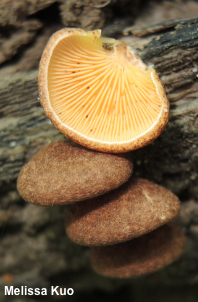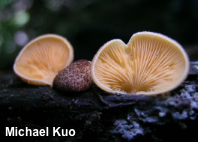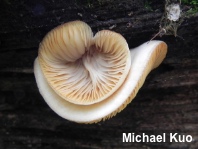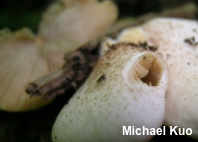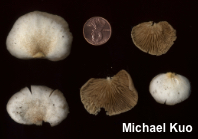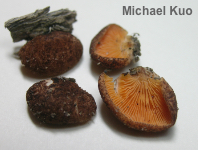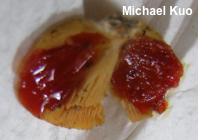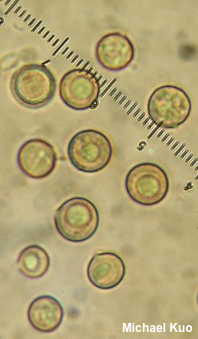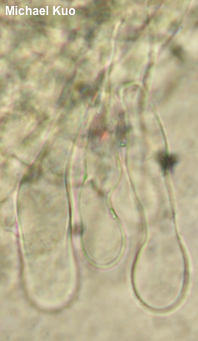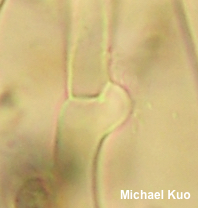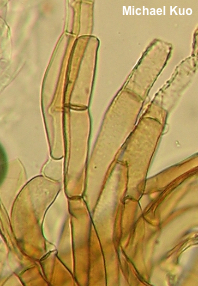| Major Groups > Gilled Mushrooms > Dark-Spored > Pleurotoid Mushrooms > Crepidotus > Crepidotus crocophyllus |

|
[ Basidiomycota > Agaricales > Inocybaceae > Crepidotus . . . ] Crepidotus crocophyllus by Michael Kuo, 12 June 2023 This is probably our continent's most common species of Crepidotus—and it is, fortunately, one of the more interesting species in a genus full of lackluster brownish mushrooms. Crepidotus crocophyllus features brown fibrils or scales on its cap, and orangish to orange immature gills. Microscopic features (see below) are also distinctive. In truth the "fibrilloseness" of the cap and the "orangeness" of the immature gills in Crepidotus crocophyllus are fairly variable. Some caps are basically whitish, with a few scattered brown fibrils, while others can be densely fibrillose and appear brown overall. Sometimes the immature gills are deep orange; other times they are a very pale pastel orange or nearly whitish. And when the gills are mature, of course, they are covered with spores and are consequently dull brown. However, the species remains fairly easy to identify if young specimens are available. Crepidotus calolepis is very similar; it also features a cap with brown fibrils. However the immature gills in Crepidotus calolepis are never orange, its flesh is rubbery, and, under the microscope, it features ellipsoid spores and lacks clamp connections. Crepidotus dorsalis, Crepidotus fulvifibrillosus, Crepidotus appalachiensis, Crepidotus aureifolius, Crepidotus distortus, Crepidotus nephrodes, Crepidotus subaureifolius, and Crepidotus subnidulans are all synonyms. Description: Ecology: Saprobic; growing alone, scattered, or gregariously on the deadwood of hardwoods; originally described from Ohio (Berkeley 1847); in North America widely distributed east of the Great Plains, in Mexico, and on the West Coast; also distributed in Central America and temperate Europe; reports from Asia represent an unnamed, separate phylogenetic species (Kasuya et al. 2014). The illustrated and described collections are from Illinois, Iowa, and Pennsylvania. Cap: 1-6 cm across; semicircular, shell-shaped, or fan-shaped; broadly convex and remaining so; whitish to dull brownish or yellowish underneath orangish brown to reddish brown fibrils that may become aggregated into small scales; the density of the fibrils ranging from sparse to very dense; hygrophanous; margin initially slightly inrolled; area near the point of attachment often fuzzy with orangish tomentum. Gills: Close; radiating from point of attachment; short-gills frequent; pale pastel orange or darker orange, becoming dull brown with maturity. Stem: Absent. Flesh: Soft; thin; whitish; unchanging when sliced. Odor and Taste: Odor not distinctive; taste bitter, or not distinctive. Chemical Reactions: KOH on cap surface reddish to grayish or black (sometimes negative on pale-colored caps); on gills bright red. Spore Print: Brown. Microscopic Features: Spores 4.5–8 µm; globose; smooth or very finely punctate; yellowish to brownish in KOH; inamyloid. Basidia 23–28 x 5–7 µm; 4-sterigmate. Pleurocystidia not found. Cheilocystidia 25–60 x 5–10 µm; cylindric to clavate; smooth; thin-walled; hyaline in KOH. Pileipellis a cutis with aggregations of upright hyphae; elements 5–12.5 µm wide, smooth or encrusted, orangish-brownish in KOH. Clamp connections present. REFERENCES: (M. J. Berkeley, 1847) P. A. Saccardo, 1887. (Kauffman, 1918; Hesler & Smith, 1965; Phillips, 1991/2005; Senn-Irlet, 1995; Barron, 1999; Ripková et al., 2005; McNeil, 2006; Miller & Miller, 2006; Bandala et al., 2008; Kuo & Methven, 2010; Kasuya et al., 2014; Kuo & Methven, 2014; Desjardin, Wood & Stevens, 2015; Siegel & Schwarz, 2016; Jančovičová et al., 2017; Sturgeon, 2018; Læssøe & Petersen, 2019.) Herb. Kuo 05310703, 06090704, 06090705, 07020801, 07130801, 05051101, 09211505, 07091606, 06151801. This site contains no information about the edibility or toxicity of mushrooms. |
© MushroomExpert.Com |
|
Cite this page as: Kuo, M. (2023, June). Crepidotus crocophyllus. Retrieved from the MushroomExpert.Com Web site: http://www.mushroomexpert.com/crepidotus_crocophyllus.html |
